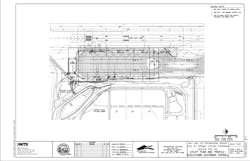Last December, during a storm that dumped 9 inches of snow on the airfield, Salt Lake City International Airport (SLC) launched a comprehensive end-of-runway deicing program, an initiative 10 years in the making. Under the program, all nine of the airlines serving SLC transitioned from airline-controlled deicing pads in the central terminal area to large common-use deicing pads near the ends of three major runways.
The Salt Lake City Department of Airports (SLCDA) operates SLC and had multiple reasons for decentralizing deice operations:
- Greater airfield safety. Constructing deicing pads at the end of runways would decrease congestion at aircraft exit/entrance ramps and gates.
- Improved out-to-off times. Having the deicing pads as close to runways as possible would reduce the need for secondary deicings and get planes on the runways faster.
- Room to expand. SLC is planning a new terminal complex and needed the space occupied by the current deicing pads for the new concourse.
- Increased sustainability. New deicing pads would allow for more efficient collection of glycol runoff to meet current and anticipated environmental regulations.
- Traffic growth and changes in fleets. Pads would support growth in carrier and cargo operations and planes of various sizes, including 747-sized aircraft.
Program is ambitious and robust
This past winter, three of the pads opened: 34L, 34R and L. A fourth deicing pad, 16L, is scheduled to open on time and as planned this fall.
At full buildout, SLC’s end-of-runway deicing program will feature six pads (three on the north end of each runway and three on the south ends), supporting taxiways, roadways and utility infrastructure. The new pads and taxiways include independently controllable centerline lighting for marshaling aircraft into each deice position and a sophisticated glycol/stormwater runoff collection system.
The program also includes up to four deice support buildings, each with a deice control center, glycol storage, mixing and dispensing equipment, deice vehicle parking, office space and break facilities for deicing crews.
SLC is among the first U.S. airports to develop and successfully implement a comprehensive deicing program. However, as expected, implementation of the ambitious program was not without its challenges.
Weather patterns change
In 2008, the SLCDA hired HNTB Corp. as primary engineering consultant for all aspects of the end-of-runway deicing program. HNTB collaborated with airport engineering and operations, FAA air traffic control and Delta Air Lines to set design criteria for each pad’s size, the number and size of aircraft it would support and its location on the airfield.
HNTB issued 13 technical memos summarizing evaluated concepts, discussions, decisions and recommendations for major project elements. As part of the evaluations, HNTB completed shadow and line-of-sight studies from the existing air traffic control tower to confirm satisfactory viewing of the new runway-end facilities and to confirm the aircraft being deiced at the end-of-runway facilities would not interfere with protected airspace and services.
Based on the data collected, HNTB produced computer simulations of various airfield operational scenarios and runway departure flows to optimize the location, size and layout of each deicing pad.
The SLCDA began the 2015-16 deice season confidently – with a set of expectations based on nearly a decade’s worth of research, simulations, data mining, design, construction and information from other airports, but some aspects of the plan, such as the weather, would remain unpredictable.
The new pads were modeled for both north-flow and south-flow runway operations. Since north flow is by far the predominate operational condition for winter operations at SLC, the first three pads were constructed on the south ends of the runways to support north flow operations. But during the first year of pad operations, most of the storms came from the south instead of the north. The unusual shift in weather pattern presented problems, as the airfield did not yet have deice pads at the north end of any runway.
It was anticipated that the L pad, the first pad constructed, would see the heaviest use, but because SLC operated in an unusual south flow, the L pad was the least desirable that first winter.
The lesson is that it’s important to periodically review assumptions to ensure they still are valid and to understand there may be some situations that simply cannot be predicted.
The basic premise of the single-provider program changes
While the pads and deice control facilities are designed to accommodate multiple deice providers, the modeling and simulation confirmed that a single-provider, common-use program would create the most efficient, safest deicing environment. Based on that, the SLCDA asked all air carriers to participate in the program. For some, it was a hard sell.
“With anything new, you have to adjust and adapt,” said Jon Beplay, Salt Lake City station manager for Southwest Airlines. “Having a third-party provider deice our planes meant we would lose some control over out-to-off times.”
Delta, SLC’s largest carrier, opted to continue its own in-house deicing program. The remaining air carriers, including Southwest Airlines, were required to contract with Integrated Deicing Services. The SLCDA still believed both deice providers could share common-use pads. However, because of congested taxiways, the 34R pad was IDS’ primary pad until approximately 8:30 a.m., at which time IDS would operate almost exclusively on the L pad. Delta’s crews would then take exclusive use of 34R and most of 34L, in preparation for their morning departure bank.
While the goal of common-use pads with a single deice provider has not been fully realized, the program has been a success because of compromise. All stakeholders found ways to make the program work through a blend of common-use and airline-controlled facilities.
Mid-season audit reveals slightly longer out-to-off times
In addition to regular meetings, the SLCDA held a program audit halfway through the first deice season. The meeting gave stakeholders an opportunity to express their concerns, talk about their experiences and be heard.
Several airlines reported improved block and arrival-at-the-other-end times. The discouraging news was out-to-off times (the time from pushback to departure) were longer by an average of one minute compared with the last three deicing seasons. The overall average out-to-off time was 37.1 minutes, with Delta reporting an average 38.2 minutes and IDS clocking in at 35.3 minutes.
The root cause of the increase was the congested taxiway leading to Delta's deicing pad, which blocked other aircraft from accessing other deicing pads. Under the new system, planes queued up at the deice pad. Before, the airlines would hold planes at the gate until a deice pad was available.
“Push-to-off times weren’t prohibitively longer, but they were longer than before the new deice pads,” Beplay said. “As time went on, we saw improvement. This year, Delta Air Lines will hold planes short of the deice pad, so the taxiway is not blocked. Based on this new solution for managing congestion, we are optimistic efficiency will continue to increase going into the new season.”
Last winter being the first year of the new deicing program, it wasn’t known if the longer out-to-off times were typical for end-of-runway pads. Having no previous-year data from which to make comparisons, all stakeholders agreed to reframe that first winter as a benchmarking season and began collecting the appropriate data. This winter, the SLCDA will be able to compare year-to-year statistics.
First season confirms a broad definition of success
By January, just one month after official launch, the end-of-runway program was running very well and the SLCDA was able to place several marks in the win column:
- The airport’s deice operations had been consolidated.
- The previous deicing pads were decommissioned, clearing the way for expansion.
- Secondary deicings were eliminated.
- Congestion was improved.
- Greater sustainability was achieved with a sophisticated glycol collection system.
- Actual time on the deicing pads was as predicted. Once aircraft were on the pads, the deicing process was smooth and efficient. Aircraft were moved expeditiously to their assigned departure runways after deice.
- What’s more, both providers were committed to the program’s success. Delta Air and IDS agreed to manage the deicing pads, freeing SLCDA operations managers for other tasks.
Going into the second season, the SLCDA and all stakeholders have the advantage of experience. But, the landscape of the deicing program will continue to evolve with the opening of the fourth deice pad. The new fourth pad will present an opportunity for improved deice operations and a challenge as everyone learns how to incorporate it into operations.
The SLCDA accomplished what it set out to do after many years of planning, negotiations, design, construction and coordination. It has set the stage for safe, efficient deice operations, future growth and environmental responsibility at Salt Lake City International Airport.
Al Stuart, AAE, is superintendent of airport operations for Salt Lake City Department of Airports. Rob Millar, P.E., serves as project manager for HNTB Corporation, a national infrastructure solutions firm. Special thanks to Doug Harris, airport operations manager, and Treber Andersen, airport operations superintendent at Salt Lake City Department of Airports for their contributions.
About the Author

Al Stuart
Superintendent of Airport Operations

